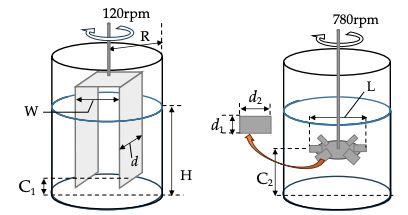
Innovative Analysis of Flow Behavior in Industrial Mixing Using UVP-DUO Technology
Introduction
In the realm of chemical engineering and industrial processes, the pursuit of efficiency and precision in mixing technologies is relentless. A recent study titled “Analysis of Flow Behavior and Evaluation of Agitation Performance by Impeller Using UVP” by Hiroya Okumura and team, presented at the 14th International Symposium on Ultrasonic Doppler Methods for Fluid Mechanics and Fluid Engineering, unveils groundbreaking insights. This study leverages the capabilities of Ultrasonic Velocity Profiler (UVP) technology, specifically the UVP-DUO system, to evaluate the performance of different impellers in a mixing process.
The Challenge of Opaque Fluids in Industrial Mixing
Industrial mixing often involves opaque, non-Newtonian fluids, rendering traditional optical measurement methods ineffective. The study addresses this challenge by using a cloudy aqueous Carboxymethyl Cellulose (CMC) solution, notoriously difficult for light penetration, thus underscoring the necessity for an alternative measurement approach.
Enter UVP-DUO: A Solution to the Challenge
The UVP-DUO system, developed by Met-Flow, emerges as a game-changer in this context. It utilizes ultrasonic waves’ Doppler effect to measure particle velocity, making it apt for both transparent and non-transparent fluids. In this study, the UVP-DUO-Mx model was employed with a 4 MHz transducer to measure the flow velocity in the CMC solution.
Innovative Impeller Performance Evaluation
The research focused on two types of impellers: the Parallel Paddle® (PP) and the disk turbine impeller (DT). The UVP-DUO technology was instrumental in identifying isolated mixing regions (IMRs) – areas where intermixing is limited. Notably, the PP impeller exhibited superior mixing performance with smaller IMRs compared to the disk turbine, indicating its efficiency in a laminar mixing field.
Key Findings and Implications
1. Efficiency in Opaque Fluids: UVP-DUO’s effectiveness in analyzing flow in opaque solutions opens new doors for industries dealing with such fluids.
2. Impeller Evaluation: The precise assessment of impeller performance, especially in non-Newtonian fluids, can lead to more effective mixing strategies and equipment designs.
3. Reduced IMRs with PP: Smaller IMRs with the PP impeller suggest a more uniform and efficient mixing process, crucial for quality control in production.
Conclusion
The study by Okumura and colleagues, facilitated by UVP-DUO technology, marks a significant advancement in understanding and optimizing industrial mixing processes. By transcending the limitations of traditional measurement techniques, UVP-DUO stands out as a pivotal tool in enhancing mixing efficiency, particularly in challenging fluid conditions. This research not only highlights the versatility of UVP-DUO but also underscores Met-Flow’s commitment to advancing industrial process technology through innovative solutions.
The scientific study is available in our Digital Library.
Harnessing UVP-DUO Technology for Enhanced Mixing Performance